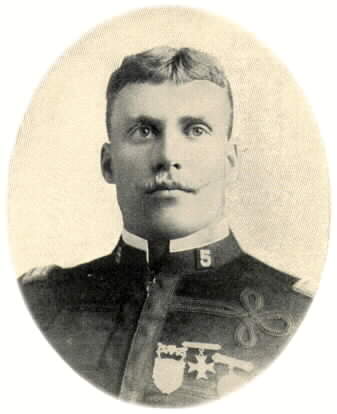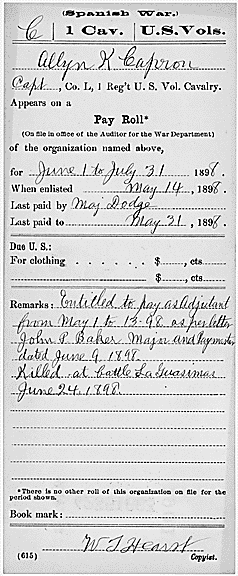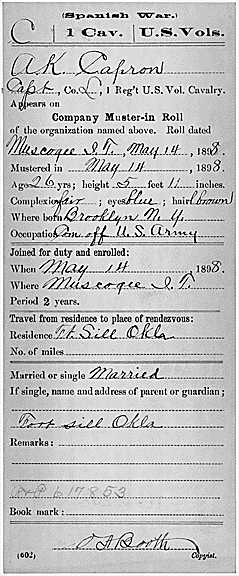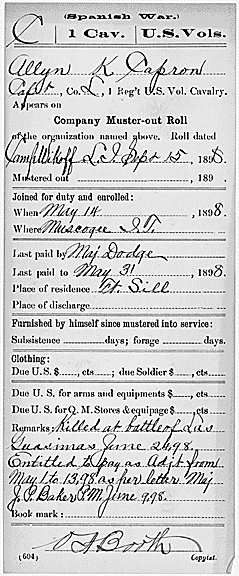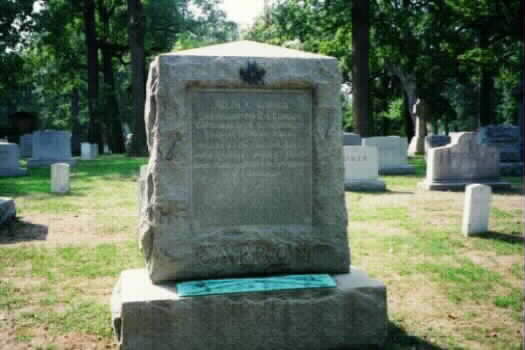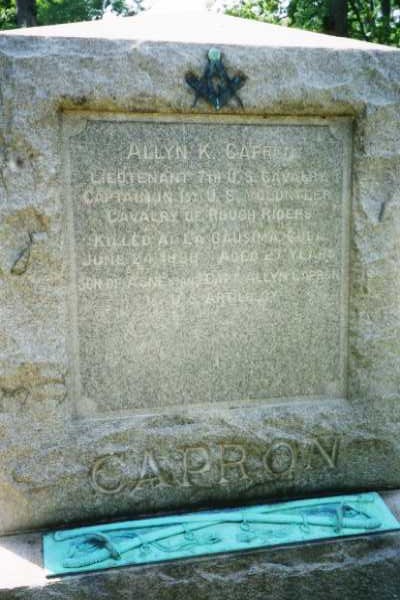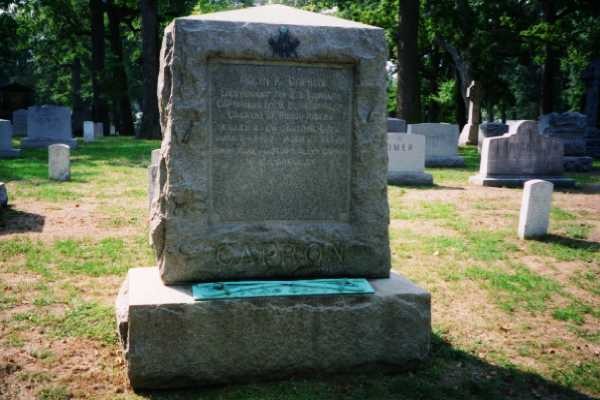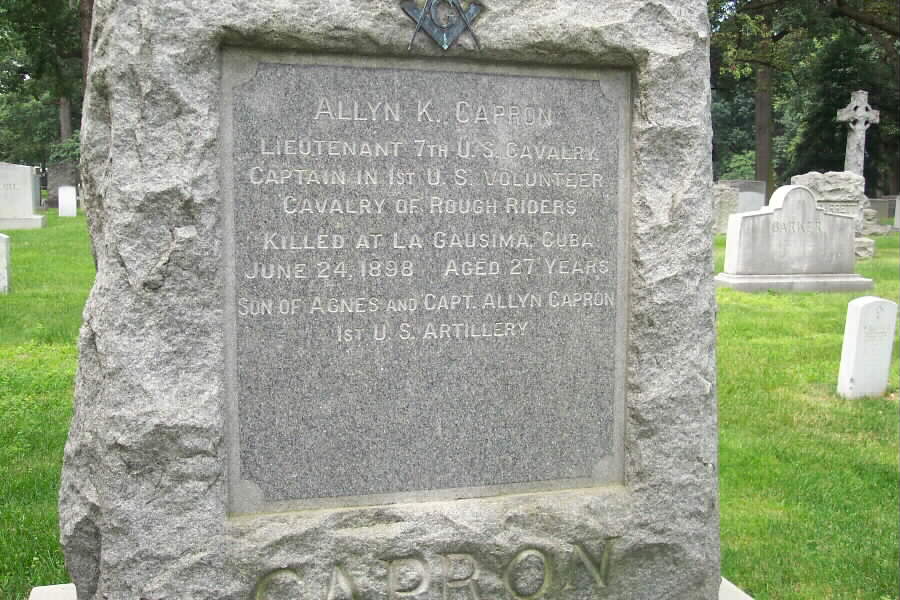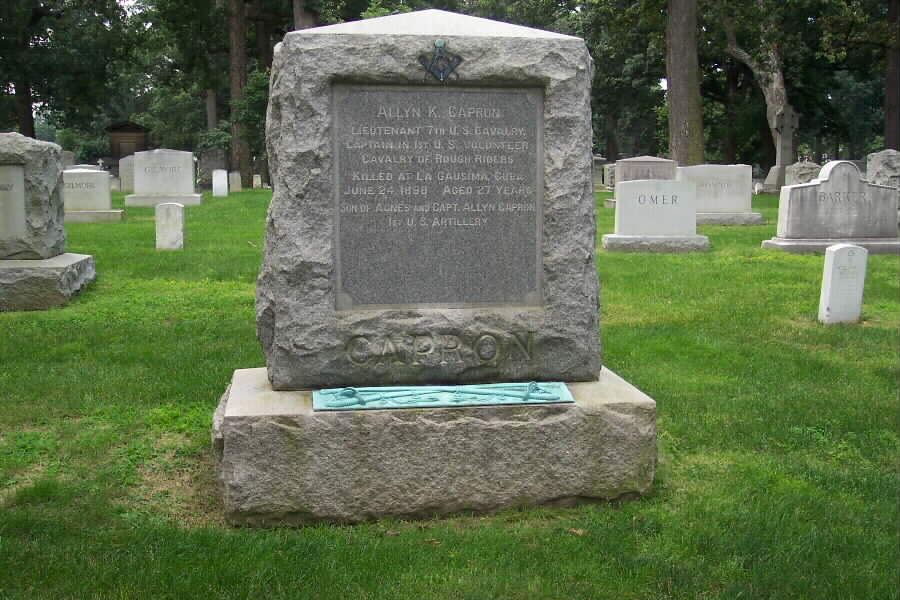Courtesy Library of Congress
Circa 1898
The son of Allyn and Agnes Capron, he was killed-in-action during the Spanish-American War on June 24, 1898. From a contemporary report:
“It was predicted that the Rough Riders would give a good account of themselves, but few were prepared for such an exhibition of dash and bravery as was witnessed in their first fight with the enemy on June 24, 1898. Captain Allyn Capron, Jr. stood behind his men, revolver in hand, using it whenever a Spainiard exposed himself. His aim was sure, and two of the enemy were seen to fall under his fire.
“Just as he was preparing to take another shot, and shouting orders to his men at the same time, his revolver dropped from his grasp and he fell to the ground with a rifle ball through his body. His troop was badly disconcerted for a moment, but with all of the strength he could muster, he cried “Don't mind me boys, go on and fight.” He was carried from the field as soon as possible, and lived for only a few more hours.
“The loss of Capron and other brave men from the Rough Riders, was a serious blow. General Nelson Miles spoke in the highest praise of Capron, saying he had been one of the best officers in the U. S. service, a man who knew no fear. Captain John R. Thomas, Jr., of Chicago, who had charge of Troop L after Capron was killed reported: “Poor Capron received his death wound early in the fight and while he was lying on the ground, dying, he said ‘Let me see it out; I want to see it all.'”
This American hero is buried among other family members in Section 1 of Arlington National Cemetery.
Allyn Kissam Capron of New York
Private, Corporal and Sereant, Troop B, 4th U. S. Cavalry, 20 October 1890 to 3 November 1893
Second Lieutenant, 5th U. S. Infantry, 7 October 1893
Transferred to 7th U. S. Cavalry, 30 November 1894
Captain. 1st U. S. Volunteer Cavalry, 10 May 1898
Killed 24 June 1898 in battle of Las Guasimas, Cuba
Captain Capron stood behind his men, revolver in hand, using it whenever a Spaniard exposed himself . . . Just as he was preparing to take another shot and shouting orders to his men at the same time, his revolver dropped from his grasp and he fell to the ground with a ball through his body. His troop was badly disconcerted for a moment, but with all the strength he could muster he cried, “Don't mind me, boys, go on and fight.” He was carried from the field as soon as possible and lived only a few hours.
“Only fifty feet from him and farther down the trail I passed his captain, with his body propped against Church's knee and with his head fallen on the surgeon's shoulder. Capron was always a handsome, soldierly looking man – some said he was the most soldierly looking of any of the young officers in the army – and as I saw him then death had given him a great dignity and nobleness.
At ten o'clock on Monday morning, an elderly, rugged looking man in uniform came to headquarters. Everybody greeted him silently. I understood why, when introduced. He was Captain Allyn Capron Sr . . . When they went to the grave I accompanied them. The body had been brought down the day before and buried, temporarily, in a desolate spot on the hillside back of the shanties. During the walk there, occasionally wiping away a tear, Captain Capron said:
“Tell me about the boy's death. I've heard nothing definite. How many times was he shot?”
Twice,” replied Dr. Ives.
“He kept on, didn't he? He didn't quit after the first one, did he?”
“No! It was the second one!”
“That's good! That's good! I knew he'd die right.”
After an impressive pause and a deep sigh, he continued: “Well! I suppose it will be my turn next. They always come in threes. His grandfather was killed in Mexico while in command of this same battery. (The fifth) I guess it's my turn next, but I hope to God that I get five good shots at the —- —- before they get me.”
There are military families in the United Sates, where the men of each generation are expected, and more often than not do follow in the boot-steps of their ancestors and takes up the military mantel of “protector of the state.”
Captain Allyn Capron Jr., who found himself leading his men into the uncertainty of battle on June 24, 1898, was a member of just such a family. He was fifth generation US Army. His grandfather had been killed in battle in Mexico some years before while in charge of the Fifth Artillery. Even as Allyn Capron Jr. led his men against the Spaniards near Siboney his father, Allyn Capron Sr. was in charge of that same Fifth Artillery waiting to be disembarked from the transport Comal, only a few hundred yards from his son's position.
As Capron and his men neared the hill where the Spanish were known to be dug in he issued an order for the men to remain silent. The men, virtually on top of the enemy positions, were ordered to load their carbine rifles. Only a few minutes after this Captain Allyn Capron Jr. lay dying with a bullet wound to his chest. Soon thereafter, unbeknonwst to his father only a short distance off, the younger Capron joined his Grandfather.
Allyn Capron Jr., by all accounts, was a tremendous soldier and a strikingly handsome officer with blonde hair and blue eyes. He had brought with him from the Indian Territories two companies, and quickly impressed all the officers and enlisted men in the Rough Riders with his tireless concern for his men, coupled with a ceaseless regimen of training. According to more than one man who campaigned with him, Capron was the finest soldier the US had to offer.
Finally, there was Allyn Capron, who was, on the whole, the best soldier in the regiment. In fact, I think he was the ideal of what an American regular army officer should be. He was the fifth in descent from father to son who had served in the army of the United States, and in body and mind alike he was fitted to play his part to perfection. Tall and lithe, a remarkable boxer and walker, a first-class rider and shot, with yellow hair and piercing blue eyes, he looked what he was, the archetype of the fighting man. He had under him one of the two companies from the Indian Territory; and he so soon impressed himself upon the wild spirit of his followers, that he got them ahead in discipline faster than any other troop in the regiment, while at the same time taking care of their bodily wants. His ceaseless effort was so to train them, care for them, and inspire them as to bring their fighting efficiency to the highest possible pitch. He required instant obedience, and tolerated not the slightest evasion of duty; but his mastery of his art was so thorough and his performance of his own duty so rigid that he won at once not merely their admiration, but that soldierly affection so readily given by the man in the ranks to the superior who cares for his men and leads them fearlessly in battle.
— Theodore Roosevelt
Roosevelt had proved himself as capable under fire as he had been behind a desk in Washington, and in the saddle on the training grounds in Texas. In the hour and half fight, the Rough Riders lost eight men dead, including Captain Allyn Capron, Jr., a fifth generation military man from Brooklyn, lately of Oklahoma, and called by Roosevelt “the best soldier in the regiment”
BURIAL OF CAPTAIN CAPRON
One Of The Leaders Of The Rough Riders Laid To Rest
WASHINGTON, July 27, 1898 – Funeral services over the body of Captain Allyn Capron, one of the gannalt heroes of Roosevelt's Rough Riders, who fell before Siboney, were held here today, the deceased having been brought North on the Government transport Hudson. The services were held in St. Paul's Episcopal Church. The coffin was hid in a profusion of floral offerings.
The Rev. Dr. Harding opened the services and a choir of young ladies sang “Nearer My God To Thee,” and “Lead, Kindly Light.” The body was then taken to Arlington, escorted by 100 men of the Fifteenth Pennsylvania Regment, where it was interred. Captain Capton's mother and wife were present, but his father is with his battery of artillery in Cuba.
TWO WIDOWS GET CITATIONS
Posthumous Silver Star Awards Made for Bravery of Two Officers
May 26, 1925
Two posthumous Silver Star Citations have been awarded to the late Captain Allyn Capron, First United States Artillery, according to an announcement made yesterday by his son, Major P. A. Capron, United States Marine Corps, of the Marine Barracks at Charleston, South Carolina.
The citations are for gallantry in the Sioux Indian campaign in 1890 and 1891 and in the Spanish-American War. Captain Capron died three weeks after returning from Cuba from the effects of typhoid fever contracted during the campaign.
The citations have been sent to his widow, Mrs. Agnes K. Capron.
A postmunous Silver Star Citation also has been awarded to Captain A. K. Capron, Seventh United States Cavalry, for gallantry in action at the battle of Las Guasinas, Cuba, June 24, 1898, where he was killed. The star has been sent to his widow, Mrs. Lillian Capron of Washington, D.C.
CAPRON, ALLYN K
CAPT CO L 1ST US VOL CAV SPAMWAR
- VETERAN SERVICE DATES: Unknown
- DATE OF DEATH: 06/24/1898
- DATE OF INTERMENT: Unknown
- BURIED AT: SITE 289ES
ARLINGTON NATIONAL CEMETERY
CAPRON, LILLIAN WIDOW OF ALLYN
- DATE OF DEATH: 01/30/1937
- DATE OF INTERMENT: 02/02/1937
- BURIED AT: SECTION WEST SITE 289
ARLINGTON NATIONAL CEMETERY
WIFE OF AK CAPRON – CAPT CO L 1ST US VOL CAV
Michael Robert Patterson was born in Arlington and is the son of a former officer of the US Army. So it was no wonder that sooner or later his interests drew him to American history and especially to American military history. Many of his articles can be found on renowned portals like the New York Times, Washingtonpost or Wikipedia.
Reviewed by: Michael Howard

